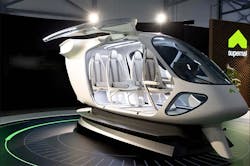Meet George Jetson: Rolls-Royce and Hyundai to Develop Flying Cars
What you'll learn:
- Specifics of what each company will provide in the collaborative effort.
- How does a hydrogen fuel cell work?
- Development of hydrogen fuel-cell power plants.
Hyundai and Rolls-Royce will join forces—combining Rolls-Royce’s aviation expertise with Hyundai’s hydrogen fuel-cell technology—to deliver a fuel-cell electric aircraft demonstrator by 2025.
Rolls-Royce Holdings, a British aviation company (a separate company from the manufacturer of luxury cars with the same name), has a long history in aviation. Currently serving more than 400 airlines, it will work together with Hyundai to create hydrogen fuel cells and storage systems.
The amount of energy stored onboard in a hydrogen fuel cell is determined by the size of the hydrogen fuel tank. This is different from an all-electric vehicle, where the amount of power and energy available are both closely related to the battery's size.
Using hydrogen as a fuel source, the companies say, offers all of the benefits of electric propulsion (such as suppressed sound and low emissions) as well as long range. The companies will work to bring hydrogen fuel cells, storage systems, and infrastructure to the aerospace market.
"The advanced air-mobility market offers great commercial potential, and this collaboration supports our joint ambitions to lead the way", said Rolls-Royce Electrical President Rob Watson.
Jaiwon Shin, President of Hyundai Motor Group, said, “We are pleased to partner with Rolls-Royce to draw upon their aviation and certification expertise to accelerate the development of hydrogen fuel-cell propulsion systems. Hyundai has successfully delivered hydrogen fuel-cell systems to the global automotive market and is now exploring the feasibility of electric and hydrogen propulsion technologies for aerospace integration. We believe this to be the key technology to support the global aviation industry’s goal to fly net zero carbon by 2050.”
Like all-electric vehicles, fuel-cell electric vehicles (FCEVs) use electricity to power an electric motor. In contrast to other electric vehicles, FCEVs produce electricity using a fuel cell powered by hydrogen, rather than drawing electricity from a battery.
Fuel-Cell Operation
Similar to batteries, a fuel cell is a device that converts energy stored in molecules into electricity through an electrochemical reaction. Composed of an anode and a cathode separated by an electrolyte membrane, a typical hydrogen fuel cell works in the following way:
- Hydrogen enters the fuel cell via the anode. Here, hydrogen atoms react with a catalyst and split into electrons and protons. Oxygen from the ambient air enters on the other side through the cathode.
- The positively charged protons pass through the porous electrolyte membrane to the cathode. The negatively charged electrons flow out of the cell and generate an electric current, which can be used to power an electric or hybrid-electric propulsion system.
- In the cathode, the protons and oxygen then combine to produce water.
- Unlike batteries that need to be recharged, fuel cells can continue to generate electricity as long as a fuel source (hydrogen) is provided.
- Individual fuel cells can be “stacked” to form larger systems capable of producing more power, thereby allowing scalability. A single fuel cell can produce enough voltage to power small applications, while fuel-cell stacks can be combined to create large-scale, multi-megawatt installations.
- Because there are no moving parts, fuel cells are silent and highly reliable.
Hydrogen is a clean, abundant, and efficient form of energy, especially when used in fuel cells to generate electricity.
“Battery-powered propulsion to fuel larger aircraft over longer distances is not possible with today’s technology,” explains Matthieu Thomas, Airbus’ ZEROe Aircraft Lead Architect. “Hydrogen fuel cells could be a great alternative because they can generate—with zero emissions—significantly more power and energy for a given weight. This makes fuel cells an extremely interesting technology to achieve our ambitions.”
Hydrogen fuel powerplant benefits include:
- Regional transport range; longer flight times than battery-powered engines.
- No battery charging required.
- Zero carbon emissions.
- Reduced noise signature.
Both Hyundai and Rolls-Royce share a vision of leading the AAM segment via battery-electric and fuel-cell electric solutions to the Urban Air Mobility (UAM) and Regional Air Mobility (RAM) markets and advancing sustainable aviation.
The Memorandum of Understanding (MOU) between Rolls-Royce and Hyundai Motor Group includes five strategic aims:
- Collaborating on the technology development and requirements of power and propulsion systems for Hyundai’s Advanced Air Mobility Division.
- Collaborating on the industrialization of Rolls-Royce power and propulsion systems for the Advanced Air Mobility market.
- Development of electric propulsion systems based on hydrogen fuel cells as an energy source for Hyundai’s RAM platforms.
- Collaborating to bring to market a joint fuel-cell electric propulsion system to the wider AAM market.
- Delivering a joint fuel-cell electric-aircraft demonstration by 2025.
Hydrogen Fuel-Cell Power Plant
Elsewhere, Los Angeles-based Hydroplane has announced a pre-launch, no obligation waitlist for the first Hydroplane hydrogen fuel-cell power plants. Pilots and aircraft owners on the waitlist will have the first opportunity to purchase Hydroplane's modular hydrogen fuel-cell power plant and will receive regular updates on the company's progress.
“Our fuel-cell electric power plant for single-engine aircraft is your opportunity to combat climate change, at altitude, by emitting only water,” said Hydroplane CEO Dr. Anita Sengupta.
Hydroplane is developing a modular 200-kW (270 hp) hydrogen fuel-cell power plant for the experimental aircraft, general aviation, and urban air-mobility markets that are said to outperform battery alternatives in endurance with no charge time.
Its novel electric propulsion power plant to replace combustion-piston-driven engines in currently certified, experimental, and future aircraft is specifically designed for single-engine aviation, as it’s lightweight with a compact form factor, highly durable, and emits only water. Hydroplane is on track to fly its demonstrator aircraft in 2023.

